Matt Smith has been busy. After some home improvements, he built a spray booth. Here’s his story!
Now that our basement work is finished, I need to build a proper spray booth. During renovations I reserved a small space in a closet where I could build a spray booth and attach venting to the duct work for our basement bathroom exhaust.
I chose to use cabinet grade plywood to construct my booth. One of my other hobbies is woodworking and I have built several cabinets in the last few years, so I had a ready stack of scrap cutoffs. I used dados to create grooves in the plywood to accept and lock together the sides of the box. I have the tools on hand to do that, but it’s not necessary. You could simply “butt” join, glue and screw the sides of the box just as easy.
The overall dimensions of the spray booth are 30-inches wide by 18-inches tall and 18-inches deep. I used a furnace filter to catch paint particles and a top mounted fan to extract the fumes. I angled the back wall of the booth to allow enough area on top to attach the fan and duct work. I initially used a brushless computer fan to extract the fumes, but it turned out to be too weak. From the closet the overhead duct for the bathroom exhaust ran 16 feet to an exterior wall of the house. Unfortunately, the computer fan just couldn’t move enough air to get good flow out of the spray booth. If you were venting a short distance, say out a nearby window, the smaller computer fan would have worked out just fine. Back to the drawing board.
After a week of contemplation and research, I found a great solution. An inline brushless (EC) fan with a 204 CFM rating. Brushless so that there were no sparks to ignite fumes and plenty of CFM’s to get the air out the booth and out the side of the house.
The fan is a multispeed AC powered fan, that is used in the grow house industry. I found this unit on Amazon for $99. It took me a while to find it as Googling sparkless fans usually came up with high end and OSHA approved fans for industrial paint applications. You should also know that brushless fans are also known as EC, or electronically commutated. These are sparkless, quiet, and low power consumption.
After I installed and tested the fan, I finalized all my duct connections. The metal joints got a couple sheet metal screws and all connections were foil taped to ensure an airtight seal. The blast gate and rubber couplings use adjustable clamps to ensure a tight seal and allow easy removal in the future. Time for some finishing touches!
I finished the spray booth with some left over bright while ceiling paint. The furnace filter is held in place with 3M fastener strips, which are like stiff plastic versions of Velcro. I added two LED light strips to each side of the booth. These strips were nice as they have adjustable light color to match your needs. I found them at the local big box store.
Some other finishing touches are the plexiglass pane on the top of the booth that allows additional light into the booth. I bought two cheap Lazy Susan spinners to allow me to rotate whatever paint subject without touching.
The sides of the booth were decked out with clear plastic shelves to hold paint. They were supposedly designed for nail salons to hold nail polish, but they hold all the major sizes of paint bottles for our hobby. They were found on Amazon and came in a ten-pack for around $30.
Having a pro paint booth has been something I’ve wanted to build for most of my life. I built many scale models as a kid. With my model railroading interests, the need is great for a proper paint space that doesn’t fill the house with fumes.
The first user of the booth was my son. He needed to paint the wing on his RC car. Hopefully my kids will be inspired to continue their hobbies and make full use of the spray booth. I’ve been building several gondola kits and they were my first models through the new paint booth.
I hope this inspires you to build a spray booth. Having proper spaces to conduct our hobbies is key to motivation for our hobby interests. Please feel free to contact me if you have any questions on how or what I did with my booth. A list of parts is noted below.
Matt Smith ( flyn96 @ gmail.com )
Parts List
- Fan
- Dust Hood (Connection of fan to the top of the booth)
- Paint Rack
- Lazy Susan
- Blast Gate
Many thanks to Matt Smith for sharing his tips and techniques to build a spray paint booth. If you build resin freight car kits, you may want to consider building a paint booth.
Subscribe to the Resin Car Works blog so you don’t miss a new model announcement. Add your email address to the Subscribe function at the bottom of the page.
Questions and comments can be posted below. Please follow the instructions so your comment can be posted. All comments are reviewed and approved before they appear. Share the blog link with other model railroaders.
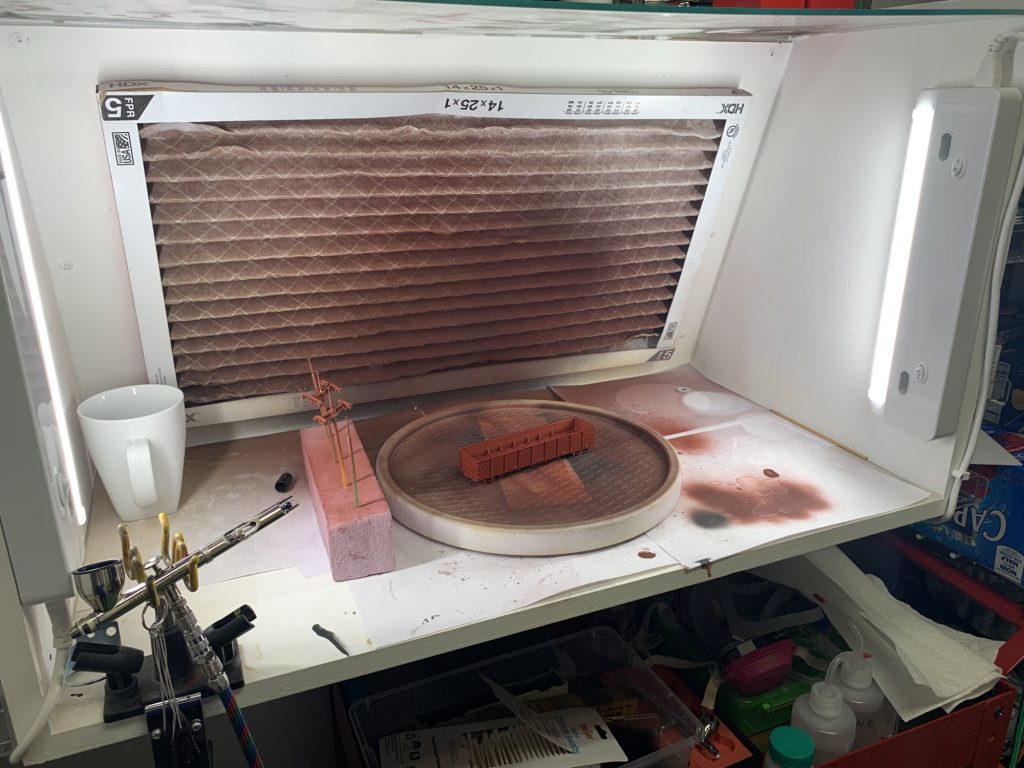
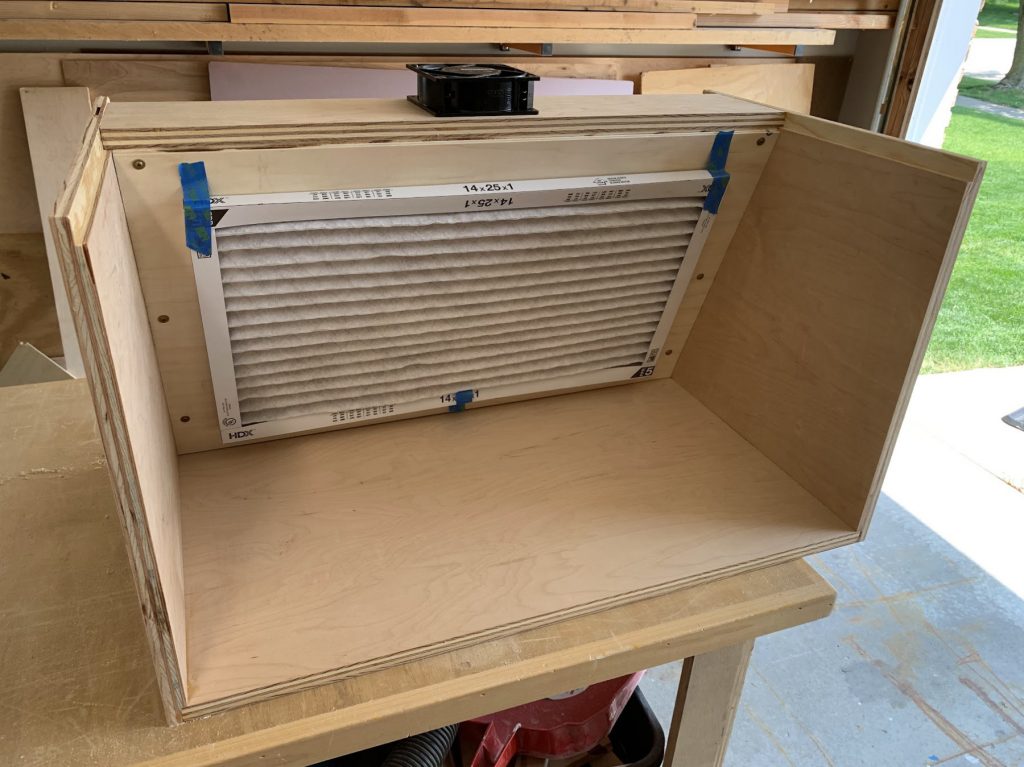

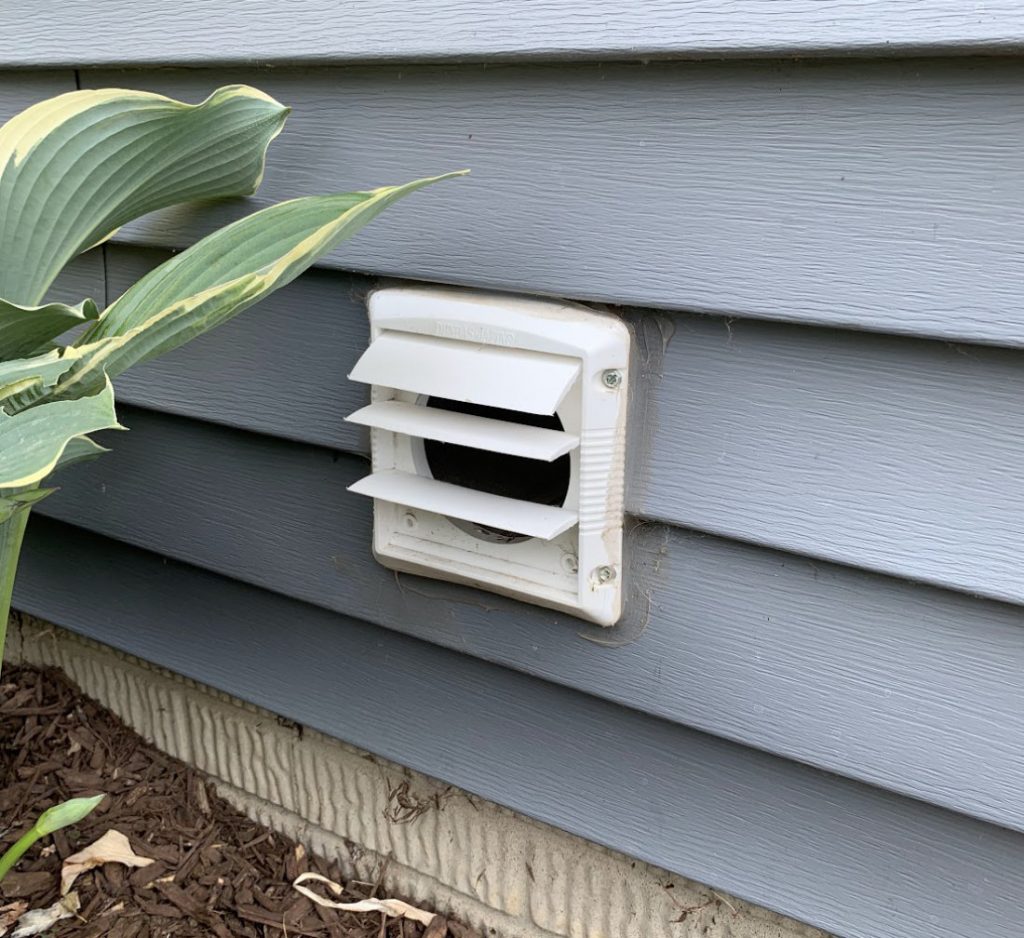
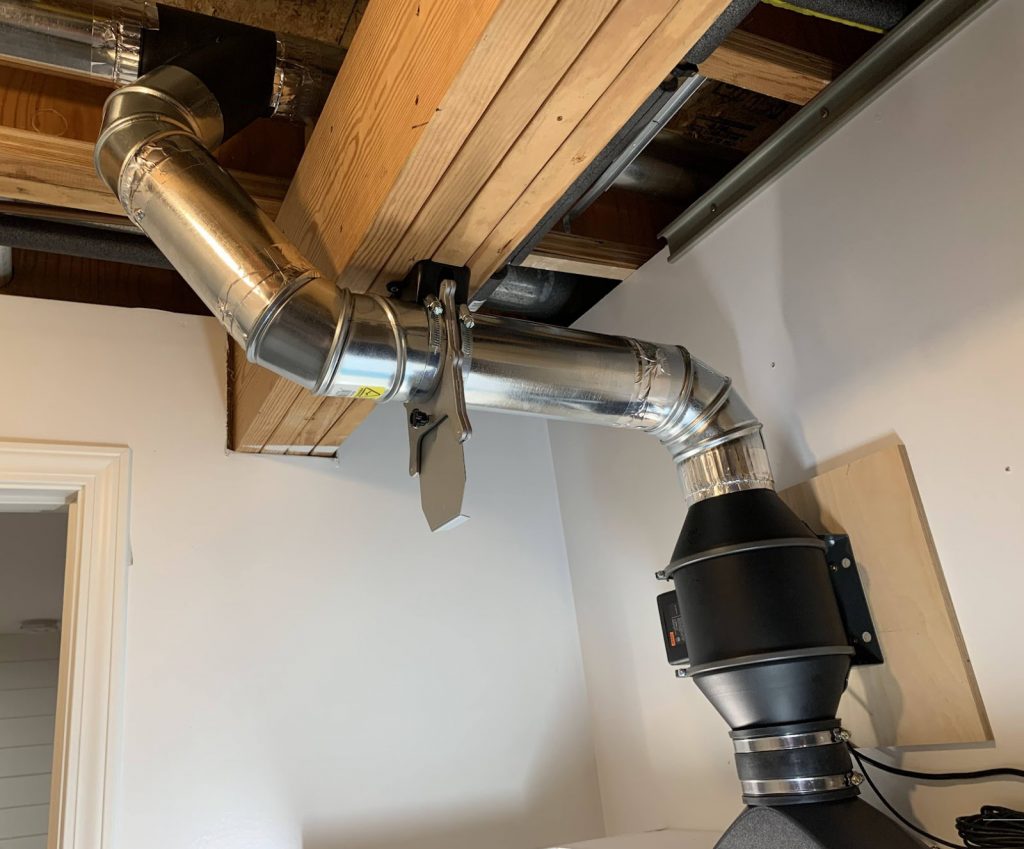

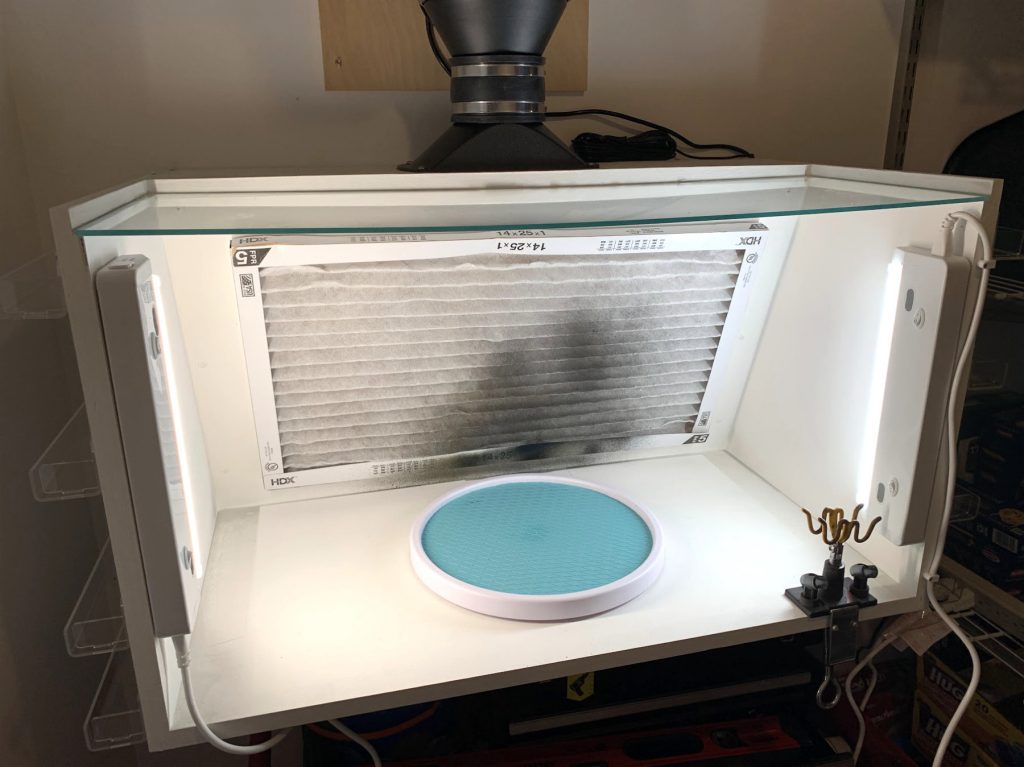
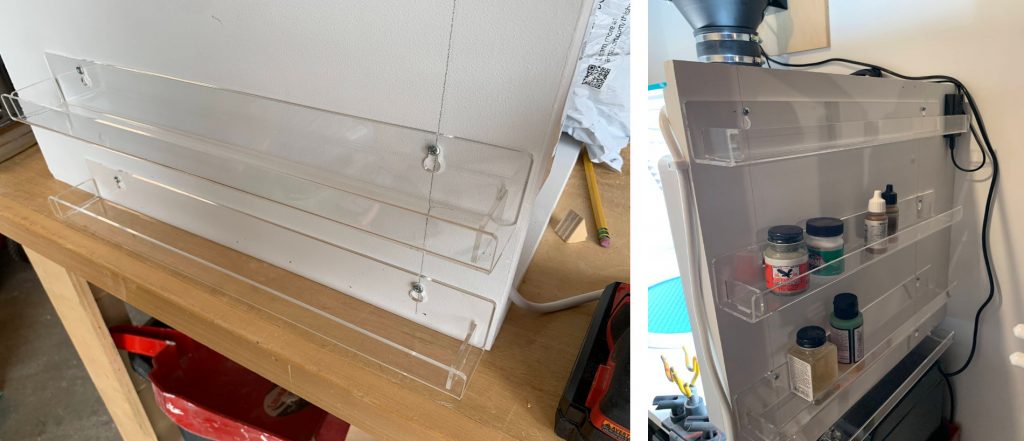
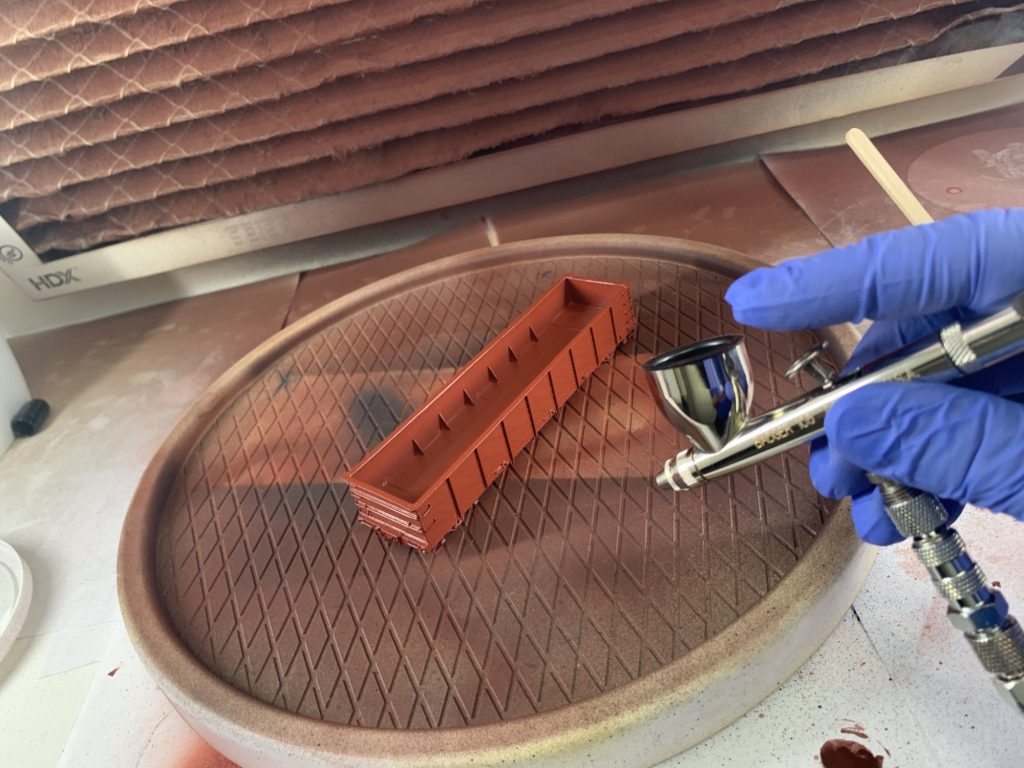
I believe that the “need” for brushless motors in airbrush spray booths comes from the requirements for brushless motors in commercial spray booths, but the size/airflow/vapor output are very different from our airbrush spray booths to a commercial booth.
I am thinking about going with a 12vdc bilge air blower. They are not very expensive. I can get a 12v 4″ hose blower for $27.99 on Amazon. https://www.amazon.com/DC-HOUSE-Marine-Blower-Electric/dp/B09J4V6FN4/ref=sr_1_6?keywords=marine%2Bblower&qid=1691435215&sr=8-6&th=1&psc=1 I have a number of 12vdc powers supplies to power it already, plus they are not expensive if I need to buy one. I can get one for $13.88 at amazon. https://www.amazon.com/Henxlco-AC-110V-Regulated-Transformer/dp/B010CVIW7E/ref=sr_1_8?crid=1SYHUUZ9TEWLB&keywords=12vdc%2B10%2Bamp%2Bpower%2Bsupply&qid=1691436371&sprefix=12vdc%2B10%2Bamp%2Bpower%2Bsupply%2Caps%2C1503&sr=8-8&th=1
So for about $42 I can have a 270CFM fan for my paint booth.
Richard Webster
Richard,
I looked at those bilge fans as well. I ended up choosing the “weed” fan because of the similar inline fan design and it allowed easy connections to standard 4″ duct work. In addition it came with an integrated speed controller. I would of had to do a bit of wiring with a bilge fan for speed control. The fan I got from amazon was essentially an off shelf ready to go option. I felt it might be a good option for folks who less wiring skills like myself!
Do you have any issues with the fumes back feeding into the bathroom from the vent? I think that I see your blast gate in the line from the paint booth.
Steve,
Nope I just run the bathroom fan, when I spray.
I built a spray booth years ago, as in, probably about 25 years. Not terribly different from what you’ve built, but much better lighting. When I get my booth relocated (I’m moving) the lighting will be improved.
I found there was no need to secure the furnace filter. The suction of the fan does a great job of holding it in place. And when I built my booth, I had several conversations with a mechanical engineer I retained as part of my architectural office busiess. I was insistent that I needed a brushless, explosion-proof fan. He asked how much paint I’d be using per session. When I said maybe 1 or two ounces over a half-hour session, he laughed out loud. “You’ll never reach a concentration of explosive vapors that would explode. Save your money.” I think he was right, in part because when the fan is going, it moves a LOT of air.
I am not saying it was foolish to go for the safety Matt was concerned about, just that it may be overly conservative.
You are correct about the too low air-mixture concentration required to allow flame ignition for the normal case of painting with an air-brush.
But what if there is an accident spill of paint thinner or if someone decides to use a spray can?
Many paint thinners will not be volatile enough to produce an ignitable mixture with air. But some thinners are very volatile. Alcohols, Zylol and MEK evaporate very fast when spilled and are very commonly used.
I’m also thinking of using the paint booth to use cheap hair spray cans often used as glue to flock model trees. The spray off of hairspray and paint cans is very ignitable near the can. Hair spray is used as the explosive fuel for potato guns. Many women smokers have experienced this danger and set their hair on fire not understanding just how true is the warning on the can.
I don’t know how much the furnace filter and a little extra distance reduces that danger. I’m thinking the filter makes a huge difference, but what if the filter is left off?
In the immortal words of Mike Rowe, Safety Third
Reynold
-Puyallup
None of those accidents/situations will produce significant enough vapor for ignition at the fan. You would need to volatilize the ENTIRE contents, simultaneously to even get close. Yes, you can light the spray at the nozzle of a spray bomb, but if you do some experiments, you sill see that you cannot ignite it more than about an inch away. The filter is more there to reduce the paint particulates hitting the fan blades. It has almost nothing to do with increased safety. So, unless you’re planning on spraying directly at the fan motor, or you build you spray booth so that spilled liquids run down into the motor (both of which seem like really dumb, if not almost entirely impossible things to do), there really is no risk.
Reynold,
Yes, spray cans of paint were my main concern. Some can really put out a large amount of paint instantly. I agree with others that airbrushing would not create enough of a hazard. However those spray cans really stink up the place and have a lot of fumes. Better overkill I think when it comes to ventilation.
This is a fantastic article about building a spray booth. I built my own booth, but I’ve been looking for a better exhaust fan, so I really appreciate the suggestion of using the in-line brushless fan. I’m going to have to get one!
Thank you again!
Jonathan
Nice build! I would make one comment though. The need for a “brushless fan” is one of those hobby myths that has no basis in fact. Several years ago, a number of us with a background in laboratory safety calculated the amount of vapor needed to catch fire in a spray booth situation, and it turns out that even volatilizing the entire contents of a 1 oz bottle of thinner or alcohol at once (impossible to do with the fan on!) does not create an ignitable concentration of fumes. Thus, the use of the best (highest volume) bathroom exhaust fan (or two) that you can buy will suffice and not create a safety hazard.